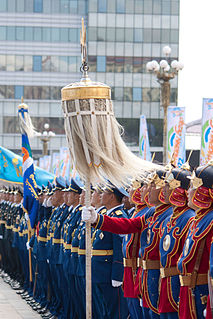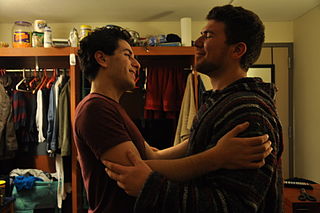 W
WThe culture of Mongolia has been heavily influenced by the Mongol nomadic way of life.
 W
WA deel is an item of traditional clothing commonly worn since centuries ago among the Mongols and other nomadic tribes of Central Asia, including various Turkic peoples, and can be made from cotton, silk, wool, or brocade. The deel is still commonly worn by both men and women outside major towns, especially by herders. In urban areas, deels are mostly only worn by elderly people, or on festive occasions. The deel appears similar to a caftan or an old European folded tunic. Deels typically reach to below the wearer's knees and fan out at the bottom and are commonly blue, olive, or burgundy, though there are deels in a variety of other colors.
 W
WGugu hat is a tall headdress worn by Mongol noblewomen during and before the Yuan dynasty. It is also known as boqta, boghta, botta, boghtagh or boqtaq. The gugu hat was one of the hallmark headdress of Mongol women in the 13th and 14th century. It was worn always worn with the formal robe of Mongol women.
 W
WHorses play a large role in the daily and national life of the Mongols; it is traditionally said that "A Mongol without a horse is like a bird without the wings." Elizabeth Kimball Kendall, who travelled through Mongolia in 1911, observed, "To appreciate the Mongol you must see him on horseback,—and indeed you rarely see him otherwise, for he does not put foot to ground if he can help it. The Mongol without his pony is only half a Mongol, but with his pony he is as good as two men. It is a fine sight to see him tearing over the plain, loose bridle, easy seat, much like the Western cowboy, but with less sprawl.".
 W
WKharkhorin Rock, also Kharkarin Rock or Phallic Rock, is a large statue of a penis raised on a platform on the steppe, located near Erdene Zuu Monastery in Kharkhorin, Övörkhangai Province of Mongolia. The phallic rock statue has dual functions; primarily it is a reminder to the monks to remain celibate, but it is also a symbol of fertility and human life. The newer, five metre tall stone statue also pictured on this page is incorrectly referenced as also being located near Kharkhorin, however, its location is noted by some as not being near the former capital city Kharkhorin, but near the smaller town of Khankhongor, much further south, in a different region. In fact, very few travel sites and blogs by frequent visitors to Kharkhorin report seeing this larger statue near the monastery. However it was removed soon after due to local people's heavy discontent
 W
WThe Khoit Tsenkher Cave Rock Paintings are found in Mankhan Sum, Khovd Province, Mongolia.
 W
WMen's and Soldiers' Day is a public holiday in Mongolia is celebrated on 18 March annually. Being the official holiday of the Mongolian Armed Forces, it is the equivalent of Defender of the Fatherland Day in Russia and/or the male version of International Women's Day.
 W
WEpic poetry, or tuuli in Mongolian, is an important genre of Mongol oral literature. The two most well-known epics are the Jangar and the Geser. These tuuli are commonly sung with instruments such as the Morin khuur and the Tovshuur (lute). Most epics deal with topics of the history of the Mongols, their ideal worlds and heroes, and the acquisition of new lands. Epics are performed mostly as celebrations or during important events. Mongol epic poetry has, as of 2009, been on the UNESCO List of Intangible Cultural Heritage in Need of Urgent Safeguarding.
 W
WThe Mongolian and Tibetan Cultural Center is a cultural center in Da'an District, Taipei, Taiwan under the administration of the Ministry of Culture. It was previously under the Mongolian and Tibetan Affairs Commission of the Executive Yuan, which in 2017 had its duties absorbed into the Ministry of Culture and the Mainland Affairs Council's Department of Hong Kong, Macao, Inner Mongolia, and Tibet Affairs.
 W
WState Flag Day is the main state holiday in Mongolia, being celebrated annually on July 10. State Flag Day is celebrated with a central government-sponsored events including a military parade and a flag raising ceremony on Sükhbaatar Square in the capital of Ulaanbaatar.
 W
W"My Native Land" is poem wrote by Mongolian poet, writer, and playwright Dashdorjiin Natsagdorj.
 W
WOvoo, oboo, or obo are sacred stone heaps used as altars or shrines in Mongolian folk religious practice and in the religion of other Mongolic peoples. They are usually made from rocks with wood.
 W
WTerlig, also known as tieli or bianxianao or Yaoxianao[zi] in Chinese, or commonly referred as Mongol dress or plait-line robe, is an archetypal type of Mongolian clothing for men.
 W
WA tug or sulde is a pole with circularly arranged horse or yak tail hairs of varying colors arranged at the top. It was historically flown by Turkic tribes such as Tuğluğ Confederation and also during the period of the Mongol Empire, and later used in derived Turco-Mongol khanates. It was also used by the Ottoman Empire, a state which was founded by Turkic Oghuz tribes. In the 17th century, it was also adopted by Slavic cavalry, under the name bunchuk which is the reflection of the original Turkic word boncuk. It is still used by some units of the Polish military.
 W
WA traditional yurt or ger (Mongolian) is a portable, round tent covered with skins or felt and used as a dwelling by several distinct nomadic groups in the steppes of Central Asia. The structure consists of an angled assembly or latticework of wood or bamboo for walls, a door frame, ribs, and a wheel possibly steam-bent. The roof structure is often self-supporting, but large yurts may have interior posts supporting the crown. The top of the wall of self-supporting yurts is prevented from spreading by means of a tension band which opposes the force of the roof ribs. Modern yurts may be permanently built on a wooden platform; they may use modern materials such as steam-bent wooden framing or metal framing, canvas or tarpaulin, plexiglass dome, wire rope, or radiant insulation.
 W
WZolgokh is a traditional Mongolian formal greeting. Two people hold both their arms out, and the younger person's arms are placed under the elder person's and grasps their elbows to show support for their elder. The two people then touch each other's cheeks, usually accompanied with the phrase Amar mend üü, meaning "Are you well and peaceful?".